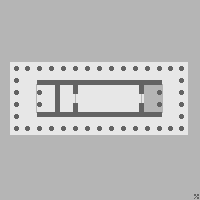Pronaos
The pronaos ( ancient Greek π πρόναος ho prónaos "in front of the naos") is the vestibule of Greek temples through which one got into the actual cult area, the naos .
This porch is formed by the front or door wall of the Naos, by the extended over the front wall, side walls of the Naos, which can transformants calls, and usually two columns at the front of Pronaos the beams abstützten and offered an open access.
The pronaos could be designed differently. Usually the entablature over the pronaos ended at the corners, for example at the temple of Zeus at Olympia , where only the frieze of the pronaos entablature bore figuratively decorated metopes , while the frieze of the ring hall remained unadorned. At the temple of Hephaestus in Athens , the pronaos beam continued over the side walkways of the ring hall in order to be continued on the inside of the ring hall beam.
At the Parthenon in Athens, the pronaos was reduced to short ante pillars; this temple did not have a column between the ante. Instead, it had a column position in front of the pronaos across its entire width, a prostasis. At the temple of Nikes on the Acropolis of Athens, the pronaos were completely dispensed with in favor of a prostyle vestibule.
A similar room at the back of the temple is called the opisthodom .
literature
- René Ginouvès, Roland Martin: Dictionnaire méthodique de l 'architecture grecque et romaine . Volume 3, 1998, p. 39.
- Gottfried Gruben : The temples of the Greeks . 5th edition. Hirmer, Munich 2001, ISBN 3-7774-8460-1
